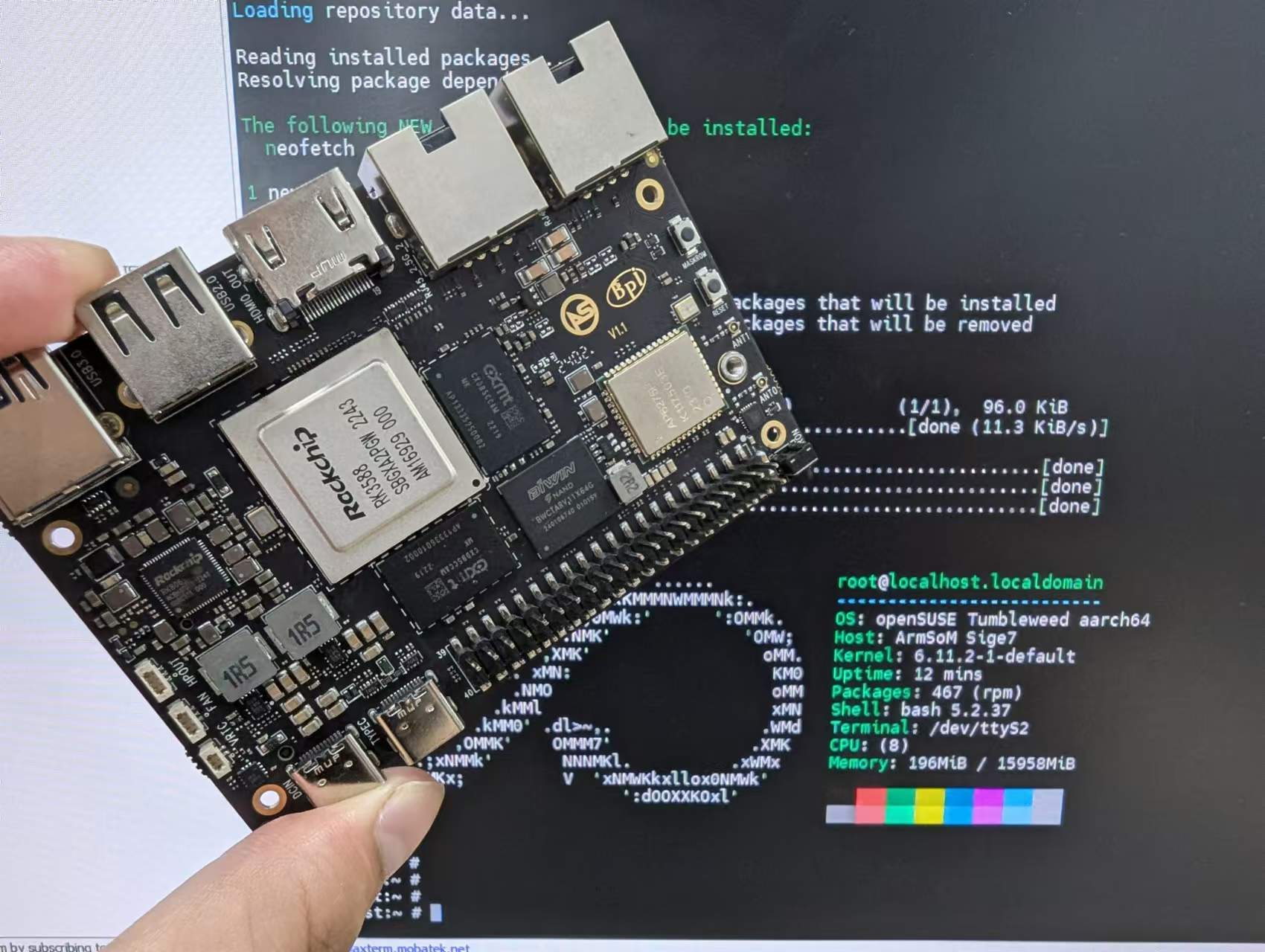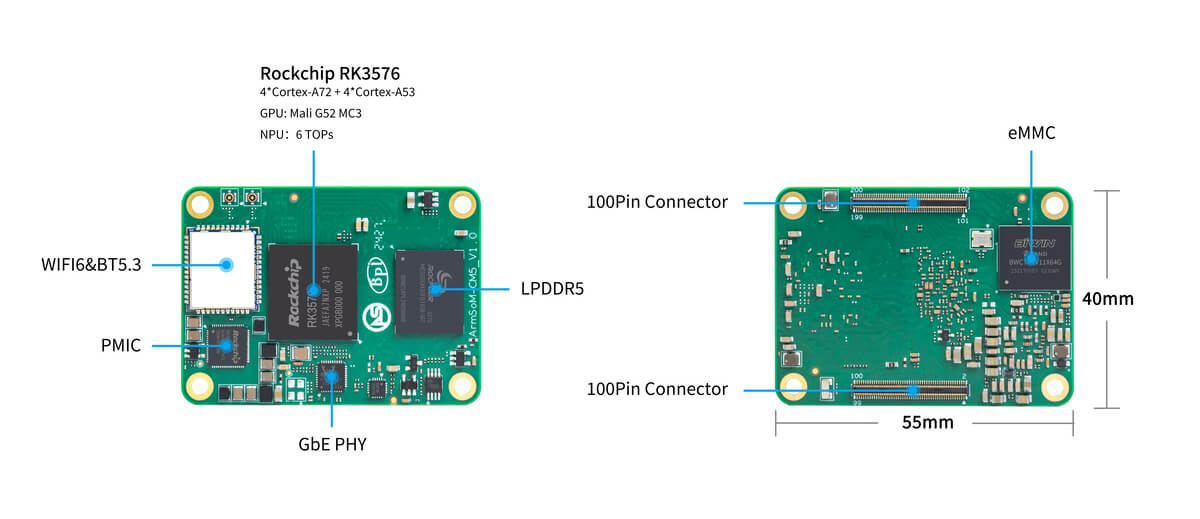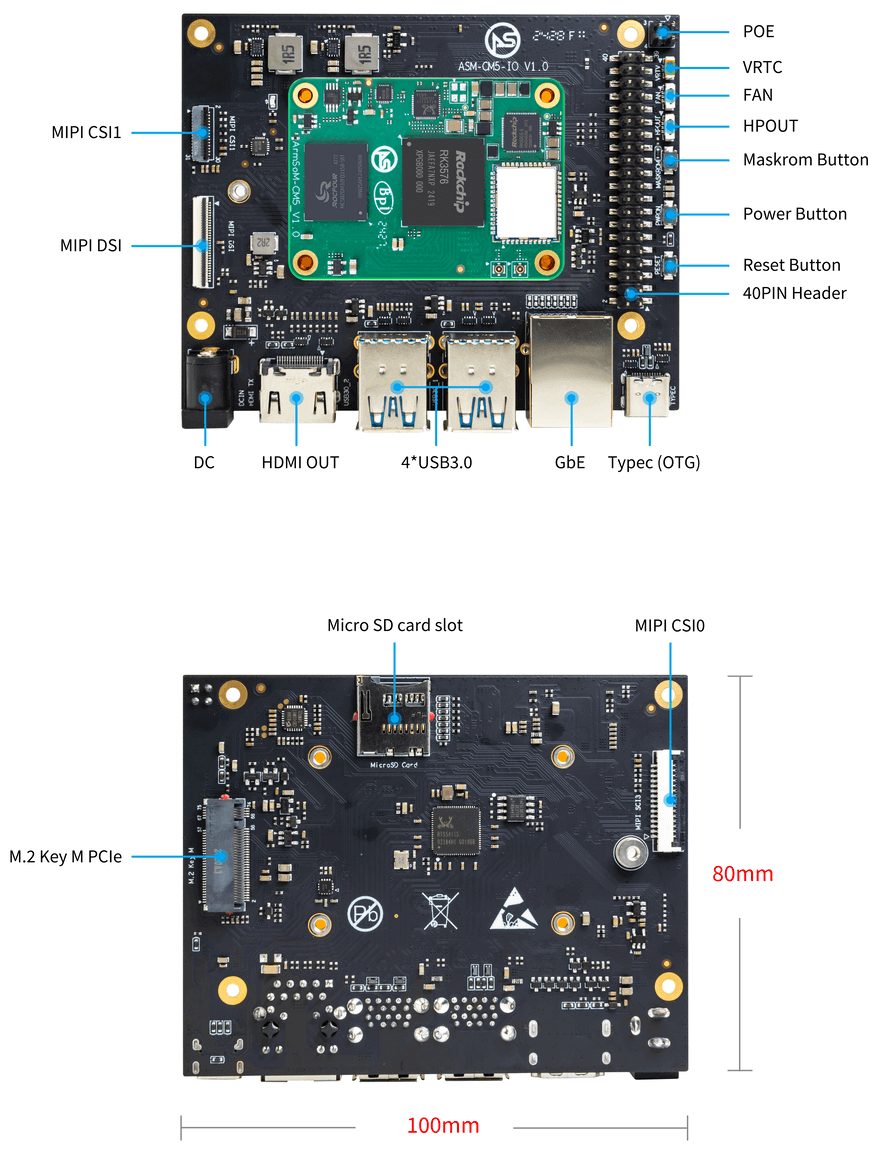Recently, we are excited to launch an all-new single board computer (SBC)powered by the formidable RK3588 , delivering unparalleled computing performance and versatile application scenarios to users.
The release of this new product marks an important breakthrough in our technological innovation and product development, providing users with a superior computing experience.
Sige7 - Connecting Innovation, Infinite Possibilities

As the core of this SBC, the RK3588 not only utilizes advanced 8nm fabrication technology but also packs a powerful multi-core processor, offering users exceptional computing capabilities. It can handle multi-tasks from high-performance computing tasks or multi-threaded applications with ease, providing users with smooth and efficient experience.
As shown in the following RK3588 CPU Benchmark test data:
Super powerful computing performance, multi-core computing power surpasses Core I3
1.1. key parameter
- SOC: Rockchip RK3588
- CPU: RK3588 Quad-core Cortex-A76@ 2.4GHz + Quad-core Cortex-A55@ 1.8GHz, 8nm process
- GPU: ARM Mali-G610 MP4
- NPU: computing power up to 6TOPs (INT8), supports INT4/INT8/INT16 mixed operations
- VPU/codec:
- Hard decoding: 8K@60fps H.265/VP9/AVS2, 8K@30fps H.264 AVC/MVC, 4K@60fps AV1, 1080P@60fps MPEG-2/-1/VC-1/VP8
- Hardcoded: 8K@30fps H.265/H.264
- RAM: 8GB/16GB/32GB (up to 32GB available) 64bit LPDDR4/LPDDR4x, default LPDDR4x 8GB
- Flash: 64GB/128GB eMMC, default eMMC 64GB
- Operating voltage: With wide range of input voltage, from 5V to 20V (voltage error ±5%)
- Working temperature: 0℃ ~ 80℃
- operating system:
- Rockchip official support: Android 12.0, Debian11, Buildroot
- Third-party support: Armbian, Ubuntu 20.04, Ubuntu22.04, Kylin OS
- PCB: 12-layer PCB board design
- weight:
- Size: 92mm × 62mm x 14.6mm
1.2. Hardware Specification
| Type | Function |
|---|
| SOC | RockChip RK3588 |
|---|
| CPU | RK3588 Quad core Cortex-A76@ 2.4GHz+Quad core Cortex-A55@ 1.8GHz,8nm process |
|---|
| GPU | GPU Mali-G610 MP4 (4x256KB L2 Cache)Support OpenGL ES3.2/OpenCL2.2/Vulkan1.1 |
|---|
| NPU | 6 TOPS@INT8(3 NPU core)Support INT4/INT8/INT16 hybrid operationSupport deep learning frameworks:TensorFlow/MXNet/PyTorch/Caffe/Tflite/Onnx NN/Android NN etc |
|---|
| VPU/codec | Hardware decoding:8K@60fps H.265/VP9/AVS2、 8K@30fps H.264 AVC/MVC、 4K@60fps AV1、1080P@60fps MPEG-2/-1/VC-1/VP8Hardware decoding:8K@30fps H.265 / H.264 |
|---|
| ISP | Integrated 48MP ISP with HDR&3DNR |
|---|
| RAM | 8GB/16GB/32GB(max 32GB )64bit LPDDR4/LPDDR4x,defaultLPDDR4x 8GB |
|---|
| Flash | 16GB/32GB/64GB/128GB eMMC,default eMMC 32GBSupport MicroSD card expansion |
|---|
| PCIe | 1x M.2 Key M interface (PCIe 3.0 4-lanes), can expand SSD:Type 2280/2260/2242/2230,currently defaults to 2280 |
|---|
| Network | 2x 2.5G Ethernet port onboard IEEE 802.11a/b/g/n/ac/ax WIFI6 和 BT5 (AP6275s) |
|---|
| Video output | 1x HDMI OUT2.1,support 8K@60fps or 4K@120fps1x MIPI DSI resolution up to 4K@60Hz1x DP1.4 resolution up to 8192x4320@30Hz |
|---|
| Video input | 2x 2Lanes MIPI CSI,Maximum 2.5Gbps per lane |
|---|
| Audio | 1x HDMI audio output1x HP-OUT audio output1x Type-C 3.0 (DP1.4)audio output |
|---|
| USB接口 | 2x USB3.0(USB3.1 Gen1), up to 5Gbps data rate 1x USB Type-C 3.0(DP1.4/OTG/PD Fast charger) |
|---|
| 40-PIN | Fully compatible with Raspberry Pi 40pin, connect to a variety of accessory peripheralsSupport UART/SPI/I2C/I2S/PWM/ADC/5V Power/3.3V Power |
|---|
| Others | 1x 5V fan interface 1x battery input connector for powering the low power RTC chip HYM8563TS 2x LED,When the system is normal, the blue light starts to flash, and the red light is controlled by the user. |
|---|
| Power supply | Support USB Type-C PD 2.0, 9V/2A, 12V/2A, 15V/2A |
|---|
| Keys | 1x PWRON key, support sleep wake1x Reset key, support reboot1x Maskrom key, support entering maskrom burn mode |
|---|
| Operation system | Officially supported by Rockchip:Android 12.0,Debian11,BuildrootSupported by the third party:Armbian,Ubuntu 20.04,Ubuntu22.04,Kylin OS |
|---|
| Size | 92 mm x 62mm |
|---|
| Operating temperature | 0℃ ~ 80℃ |
|---|
2. Diverse Application Scenarios
This SBC is not only a device with excellent performance, but also an extremely imaginative product suitable for DIY by geeky hobbyists.
ArmSoM-Sige7: AI+8K+Perception+Connectivity+Display, Building the Next Generation Flagship AIOT Platform
2.1. Sige7 (RK3588) 6TOPS Computing Power
With 6 TOPS computing power, Sige7 can support mixed-precision operations including INT4/INT8/INT16/FP16. Its powerful compatibility can easily convert network models based on TensorFlow/MXNet/PyTorch/Caffe and other frameworks.
The computing power is sufficient to support embedded systems such as smart cameras, smart home devices and autonomous vehicles for real-time image processing and analysis. It can handle some lightweight AI tasks like speech recognition, image recognition and object detection.
2.2. Sige7 (RK3588) 8K Visual Feast
Sige7 supports:
- Hardware Decode: 8K@60fps H.265/VP9/AVS2, 8K@30fps H.264 AVC/MVC, 4K@60fps AV1, 1080P@60fps MPEG-2/-1/VC-1/VP8
- Hardware Encode: 8K@30fps H.265 / H.264
Thanks to 8K video encode and decode technology,it brings the ultimate visual enjoyment with more content and finer details.
2.3. Abundant Interfaces of Sige7
Sige7 can also serve as a RK3588 development board:
Versatile and Universal: Considering the connection needs of different types of peripherals and sensors, rich interface types are provided, including digital input/output, analog input/output, communication interfaces (UART, SPI, I2C), USB, etc., meeting the needs of various application scenarios.
Easy to Use: Clear labeling, color coding, physical shape design can reduce misoperations, improving development efficiency.
Expandability: Fully compatible with Raspberry Pi 40pin, can serve as a substitute for Raspberry Pi 5.
Debugging and Diagnostics Support: Debugging and diagnostics needs are considered in the design, including providing debug adb interface, LED indicators, serial debugging, etc., helping developers more easily locate and resolve issues.
As an embedded development kit, the reasonably designed interfaces of Sige7 balance multiple aspects of needs, providing convenient, flexible and reliable interfaces for developers to carry out hardware development and debugging more efficiently.
2.4. Sige7 Adapted to Various OS
Sige7 is adapted to various systems, allowing developers to work in different development environments. Such flexibility helps meet the needs of different projects and applications.
3. Sophisticated Hardware and Appearance Design
In addition to the powerful chip performance and diverse application scenarios, our design team also focuses on the overall appearance and hardware design of the SBC. The exquisite casing and compact structure allow it to stand out in various environments, while ensuring excellent heat dissipation to stabilize operation.
4. Open Source Support
To better meet the needs of developers and technology enthusiasts, we are committed to providing open source support. Users can easily access and modify the system to customize an application environment tailored to their needs. This open design philosophy aims to inspire innovation and advance technology.
5. Conclusion
The launch of this brand new SBC powered by RK3588 is not only a demonstration of our technological strength, but also a response to user needs.
We believe that through continuous technological innovation and product optimization, we will be able to provide users with more and better products to help them achieve greater success in different fields.
Thank you all for your support and attention. Let's usher in a new chapter of technology together!
Sige7 Documents Link







